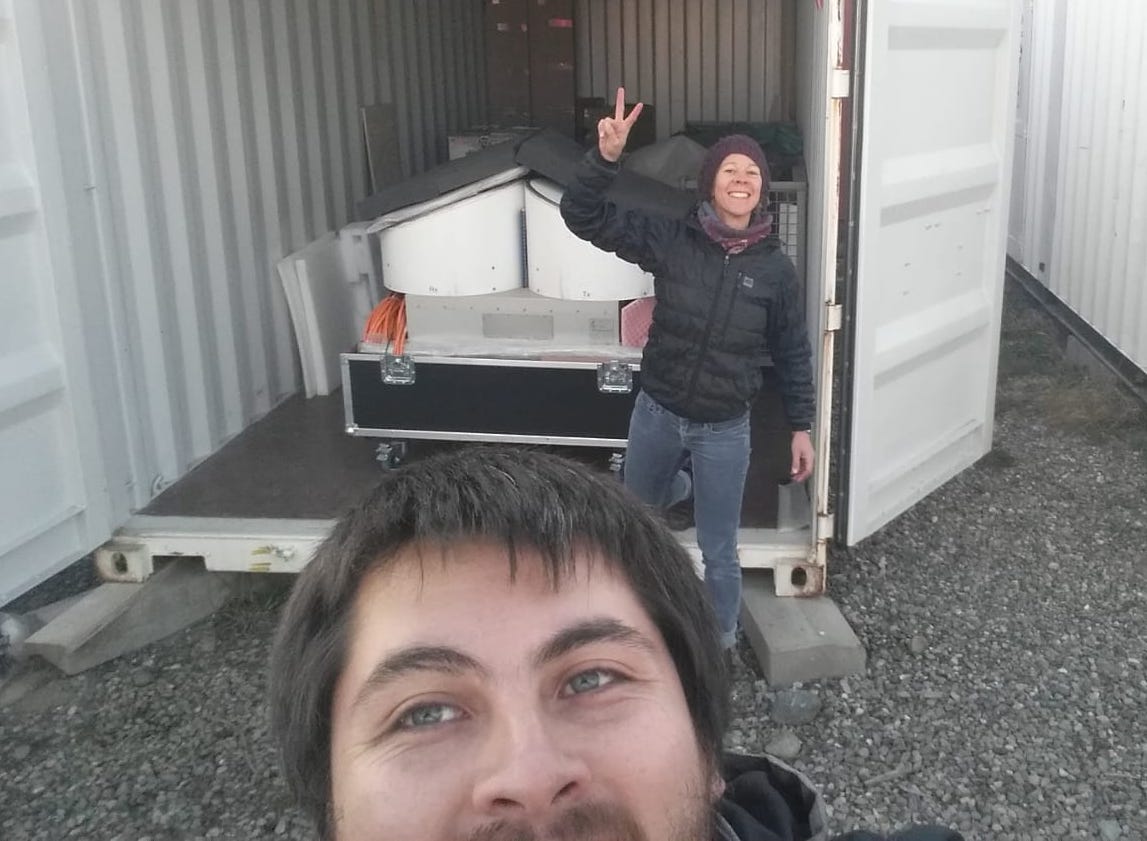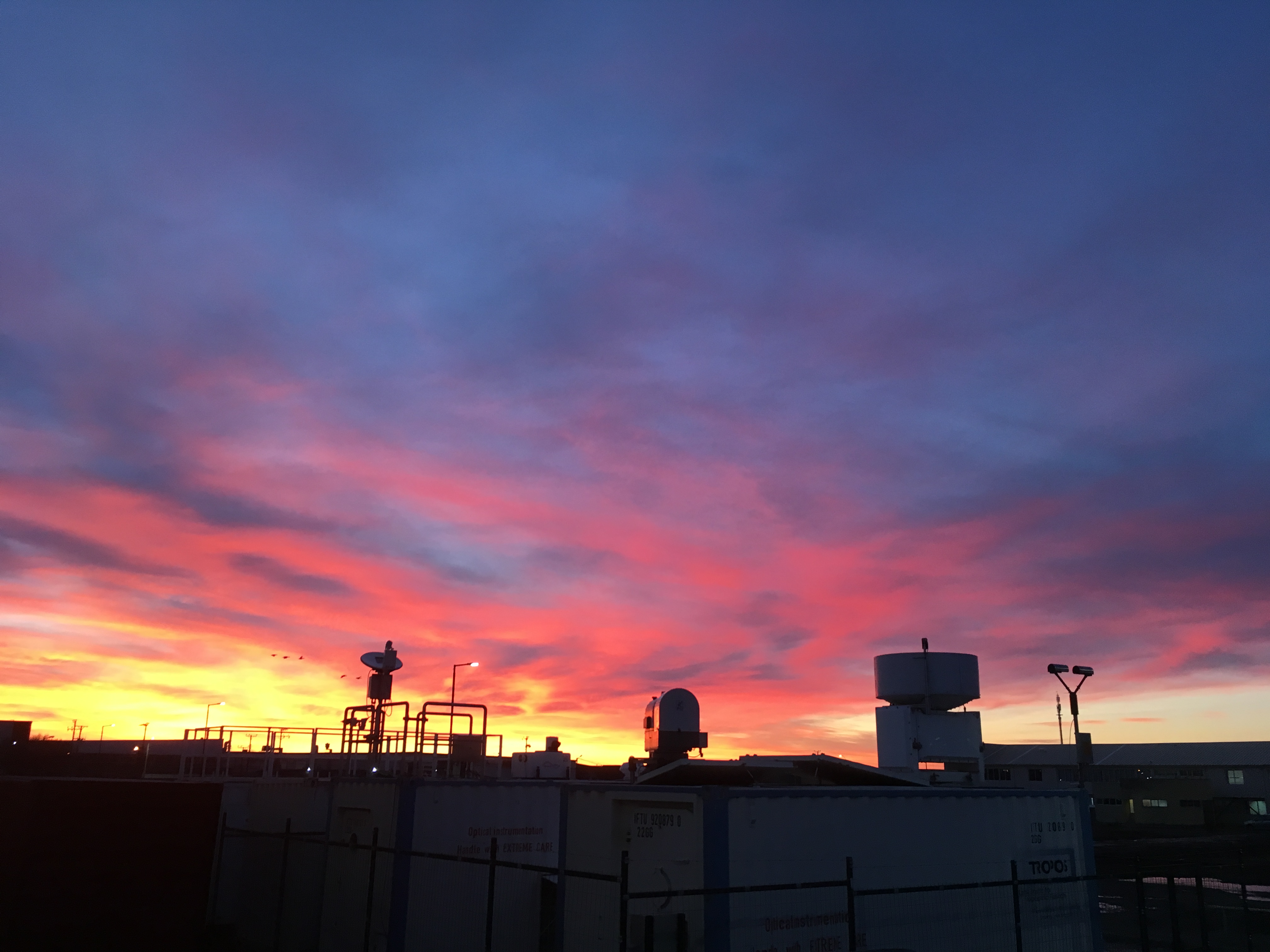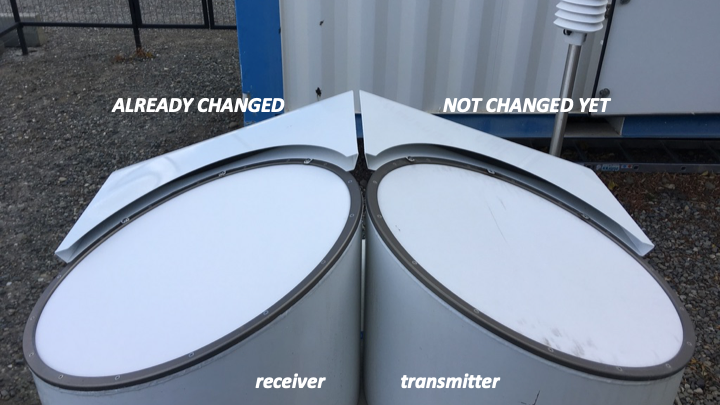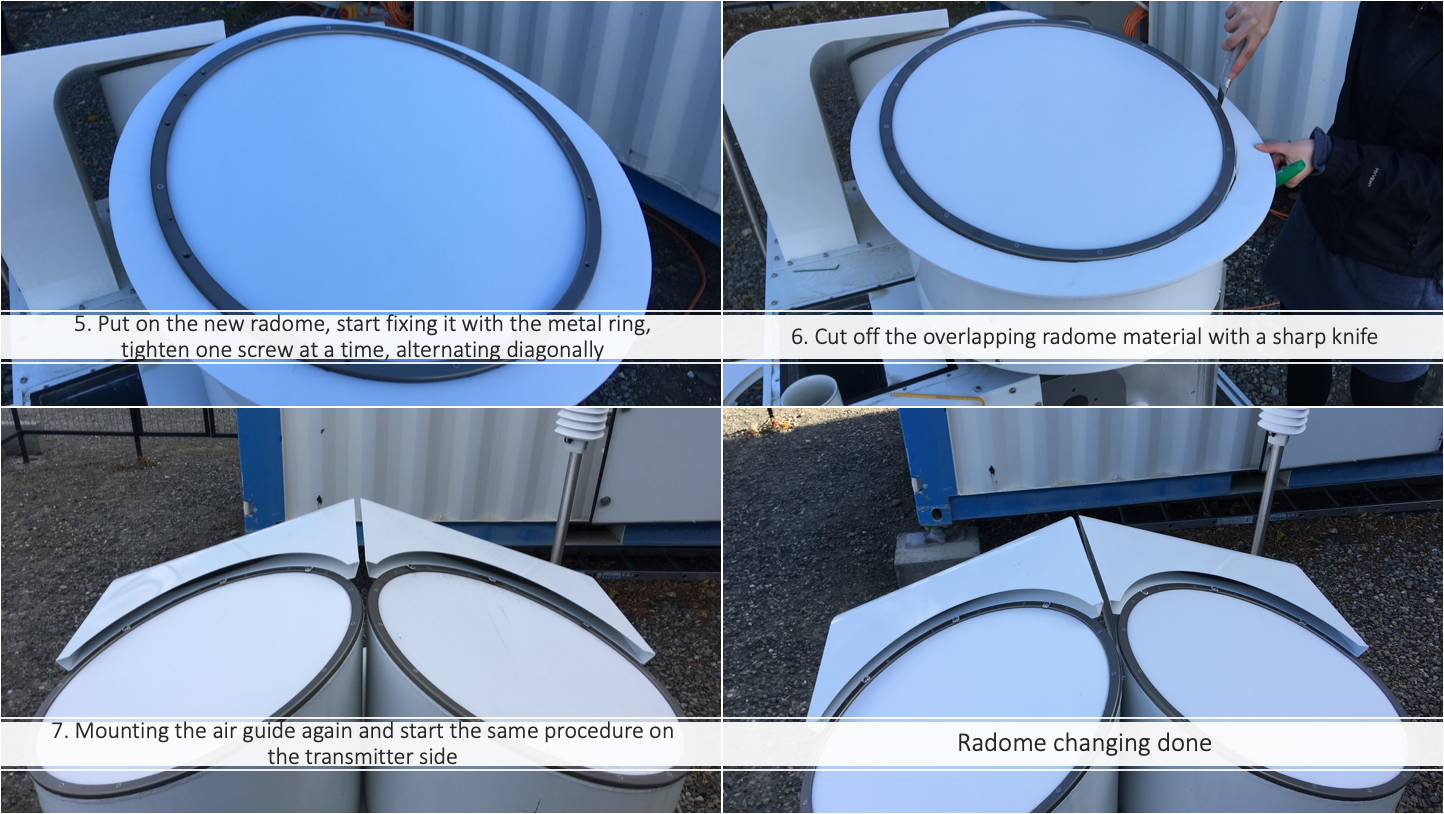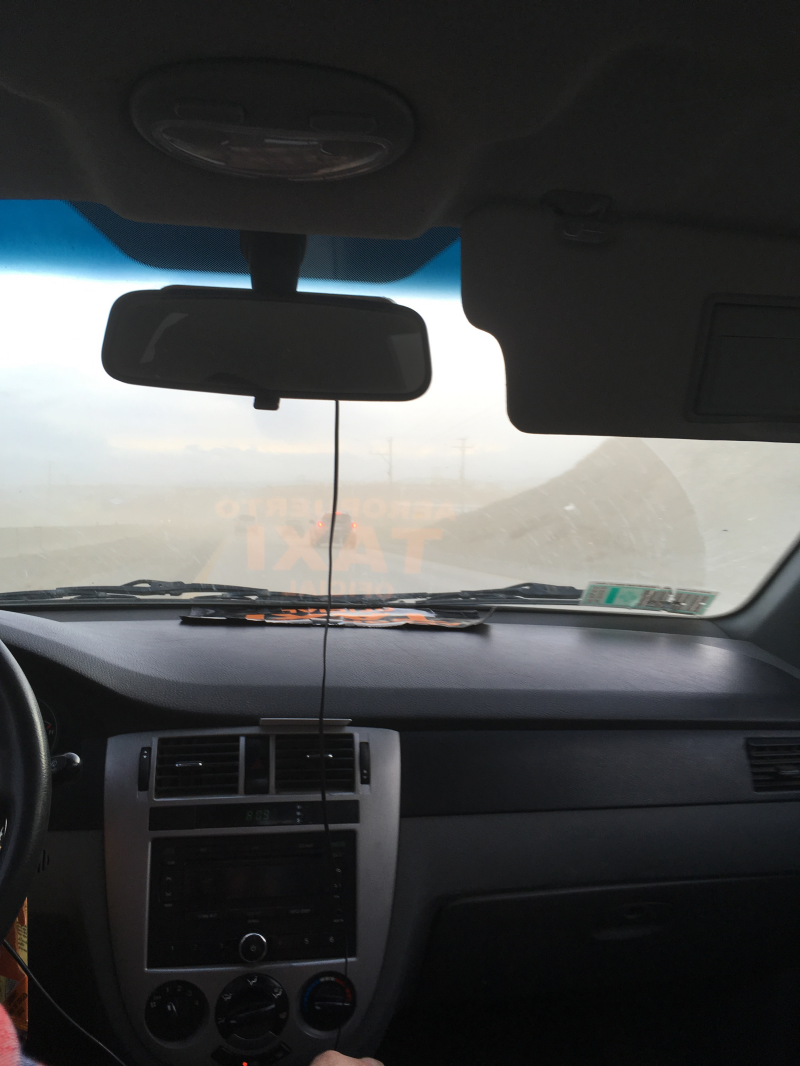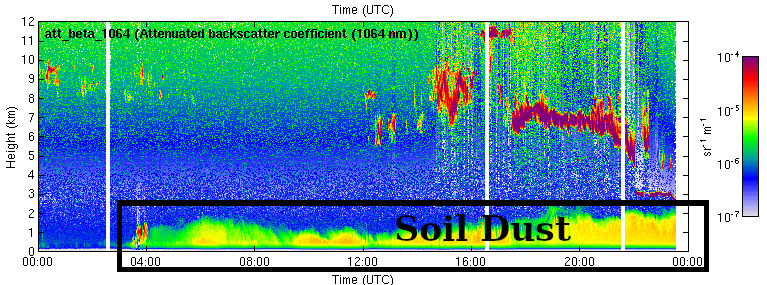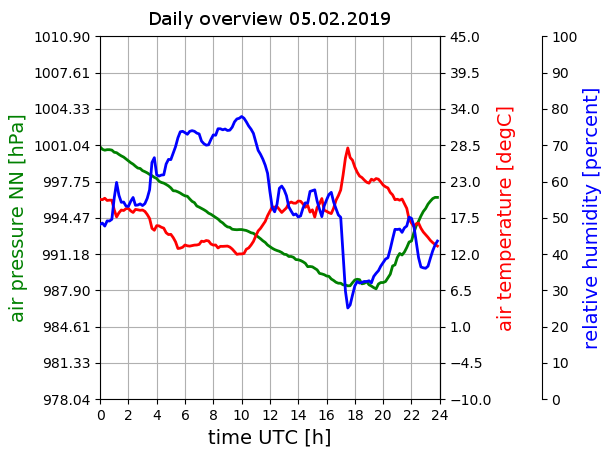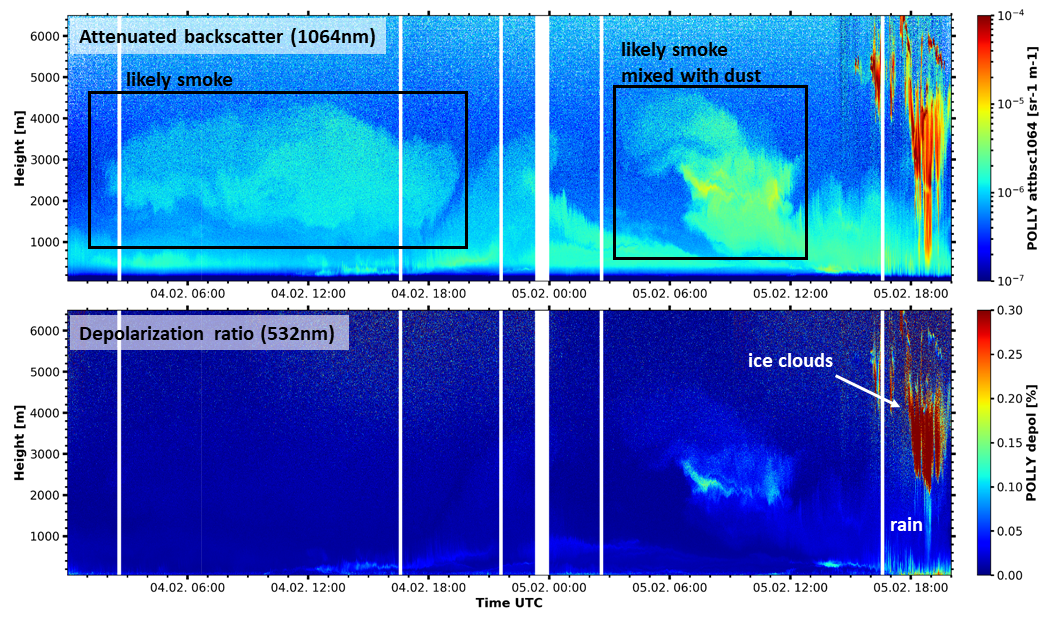It is getting spring in Punta Arenas (yes, two digit maximum temperatures are possible now!).
For one of the instruments this means time to go home. The 94 GHz radar LIMRAD94 from LIM has been turned off and packed on Sep 25.
It has been gathering data non-stop for nearly 10 months and needs some maintenance before it can go onto its next adventure: a ship-borne deployment onboard the RV Meteor at the field experiment (eurec4a) off of the coast of Barbados to study trade-wind cumuli in the beginning of next year. Having radars point exactly to zenith on a ship is of course only possible with a stabilization platform. We will test the newly-built platform at the manufacturer RPG in Germany in October.
Have a save trip, LIMRAD94!
[hk]
More than three months LACROS has operated more or less unattended in the far south of Chile. In beginning of July, the mid-campaign-maintenance-team arrived. A couple of tasks was rather straightforward and could be done rather quickly, weather permitting. The 95 GHz cloud radar LIMRAD was outfitted with a pair of new radomes (covers that protect the antenna from the environment, but are transparent to radiation with wavelengths of a couple of millimeters) and the microwave radiometer HATPRO was re-calibrated.
Others required some more fiddling. Measuring the pulse shape of the 35 GHz cloud radar MIRA required an oscilloscope and some disassembly of the scanner on the container roof. Nevertheless, the effort was justified. The pulses are still as fine as they were years ago. The other issue, strange effects in one of the PollyXT lidar channels could be narrowed down, but not be fully resolved yet. Some more equipment for alignment checks needs to be brought to Punta Arenas.
Winter weather down here is quite variable: rain, snow, sunshine, mid-level clouds, wind and calms everything at quite a rapid pace. More common than during summer time are cyclone centers passing through to the north. At times, these easterly winds likely intensify precipitation by orographic effects.
For the next two and a half months, again a couple of researchers from Leipzig will take care of LACROS onsite at Punta Arenas.
[mr]
This is the old receiver radome of the 94 GHz RPG radar from the Leipzig Institute for Meteorology (LIM), short LIMRAD94. It transmits radiation at this frequency (94 GHz) through the transmitter antenna vertically upwards into the atmosphere. When the emitted microwave radiation reaches clouds and precipitation particles, is scattered. The part of the radar signal which is returned back exactly to the radar is measured by the receiver antenna. Both transmitter and receiver are covered with a so-called radome, that is a thin hydrophobic membrane, somehow similar in its material properties to those of camping mats: The sheets are very light and soft but still firm. On the upper side, they are covered with a water-repelling layer.
These sheets have to withstand all kinds of weather: Storm, rain, hail, heat and frost, just to name a few extremes. Also, dirt and small debris that is sucked in through the blower which blow strongly over the antenna to keep water droplets from accumulating on the radomes leave their traces. As a consequence, the radomes age gradually and lose their water repellent property. The manufacturer thus suggests replacing the radomes after 6 months. We exchanged both the transmitter and the receiver radome this week. In the picture above, you can see a comparison between the receiver radome, which has already been changed, and the transmitter radome, which is not changed yet. You can see that they look considerably different: The old radome has some scratches and is a lot dirtier than the shiny, white and new radome on the receiver side.
Changing the sheets was not that hard: First of all, of course the instrument had to be switched off. Then we started to remove all the screws fixing the old radome to the radar. It is fixed by a metal ring, which has to come off. Removing the old sheet, we could catch a glimpse at the inner radome which is covered by the outer radome, the one we changed. Then we put the new radome in place by fixing screws through the holes of the metal ring into the soft radome material.
You have to be very careful not to puncture the new radome sheet.
After both radomes were changed LIMRAD94 was switched on again. A short moment of tension before the first data coming in showed that everything was alright. :-)
[TV, WS]
Last Friday and Saturday, the wind here in Punta Arenas was extreme, even for the local standard. It might not have been the perfect time to arrive here via airplane, but on the other hand, the landing was a real experience, something to remember later on. A striking thing about the weather situation was the heavy, stormy wind in connection with bright sunshine. Looking out of the window, you wouldn’t imagine almost being blown off the street when going out for dinner. The wind also wasn’t very cold, so being outside was actually quite enjoyable.
The Centro Meteorologico Maritimo reported a maximum wind speed of 58.2 knots, or 108 km/h. On social media, people shared the experiences they had with the unusually strong wind: Windows were broken and power outages were reported in parts of the city. Someone uploaded a video from an airplane landing on Saturday, in which one can see a little bit of the swaying of the plane, followed by a rather rough landing.
Lots of flights were canceled on Saturday and consequently, there was a big chaos at the airport. This complicated retrieving my suitcase, which was lost the day before when I flew to Punta Arenas. Luckily, the baggage (which contained some important cables and switches needed for the site) was there on Saturday.
The wind raised quite a lot of dust, which complicated car traffic in addition to the heavy wind gusts. So on top of having to steer against the wind, the view was also obstructed by a thick dust plume from time to time. A truck besides the road was actually overturned. Riding the taxi on the way from/ to the airport was quite exciting:
We can also see this dust in our lidar data. The dust stays in the lower atmosphere, below 2 km altitude, as can be seen in the POLLY backscatter (1064 nm).
When checking our remote sensing data, we noticed that we cracked some of the standard color scales in our quicklook plots: The Shaun wind lidar quick look plots show only dark red arrows during the first half of February 16, starting in the second height bin. Below, surface friction slows down the wind at least a little bit so that it’s “only” around 20 m/s, or 70 km/h. Shaun measures the horizontal and vertical wind. In the graph below, the left panel shows the horizotal wind. Vertical wind was exceptionally high as well, which can be seen in the radar data: The Doppler velocity, which can be translated to the combined vertical wind + fall velocity of cloud particles, is shown in the left panel below. Also here, the color scale is not wide enough to accommodate the vertical wind speeds of sometimes almost 4 m/s:
Both graphs show the time on the horizontal axis and the height in the vertical coordinate. The color scale depicts the wind speed. Red means very high wind velocities.
[TV]
During the first days of this week, we had quite special meteorological conditions at Punta Arenas. Persistent wind from the north brought unusually warm air to the Magallanes region. Together with the absence of clouds and hence strong heating by the sun, surface temperatures climbed to extraordinarily high values. On Monday (4 Feb), the maximum temperature at Punta Arenas airport reached almost 25°C and on Tuesday the maximum was 28°C. Long-term temperature records were set for several other stations throughout the region, as for example Porvenir and Puerto Natales with both above 30°C (https://twitter.com/meteochile_dmc/status/1092808761167831040). On Tuesday evening, the heat period came to a sudden end, when a cold front arrived. This is nicely visible in the surface observation (at the UMAG roof platform, shown below) as temperature drops by 15°C (red curve) and pressure increases (green curve) after 17:30 UTC (14:30 local). A nice feature is also the jump in temperature and drop in relative humidity (blue curve) directly before the front, which is probably caused by Föhn effects as the wind increased and backed toward westerly directions.
But the airmass from the north did not only bring high temperatures, but aerosol as well. Our lidar PollyXT (see also prior blog posts here and here) detected several lofted layers between 1 and 5km height on Monday and Tuesday. Several plumes are visible in the backscatter signal. One with rather weak backscatter and low depolarization ratio on Tuesday and another one with higher backscatter and some features with higher depolarization ratio.
The aerosol optical depth, a measure for total aerosol load in the atmosphere, reached values up to 0.1 (at a wavelength of 500nm). The spectral dependence between 440 and 870nm (called Ångström exponent) was around 1.5, indicating predominantly small particles with a diameter well below 1μm. Based on their optical parameters these particles are most likely smoke caused by wildfires, on Tuesday maybe mixed with some soil dust.
We were not yet able to pin-down the source of this aerosol plume unambiguously. Two source regions are possible: either the forest fires in the Region of Araucanía in Chile or the fires on Tasmania, Australia. Simulations with the HySPLIT (https://www.ready.noaa.gov/HYSPLIT.php) trajectory model (a model that traces the pathway of air parcels), show that the airmass, which was at Punta Arenas in 3km height on Tuesday 12 UTC (9 local) crossed both region during the prior 10 days. We are thus looking forward to have to solve yet another research puzzle.
[mr]
On Thursday evening, LACROS was struck by a power failure that affected the whole university. After almost 3 hours electricity was available again and we were able to put most instruments operational again right after the incidence. The cloud radar MIRA required some more attention by the on-site personal and the remote support from Leipzig. On Friday, we could narrow down the problems to an ethernet connector. Let us hope that the backup connection will work until we can fix the problem.
The cause for this interruption were very strong winds during the whole day. A low-pressure system over Drake street triggered west-north-westerly flow at Punta Arenas. Supported by the terrain, this situation seems to favor strong surface winds at the city. Below you can see the observations of our scanning Doppler lidar, which (among other things) can measure profiles of horizontal wind velocity and direction. As the signal requires the presence of particles, that scatter the light back to the instrument. Hence, continuous information is usually constrained to the boundary layer – the layer of the atmosphere, which is directly coupled to the ground and contains comparably high amounts of aerosols. Shown is a time-height series of the full day. Above 700 m the strong winds persisted the whole day, but affected ground only at around 10 UTC (7 local) and after 17 UTC (14 local).
The strongest gusts at the ground reached 107km/h in the city and 117km/h at the harbor. The local newspaper also reported on this issue: https://laprensaaustral.cl/titular1/temporal-de-viento-dejo-multiples-estragos-en-punta-arenas/
[mr]
Page 2 of 4

